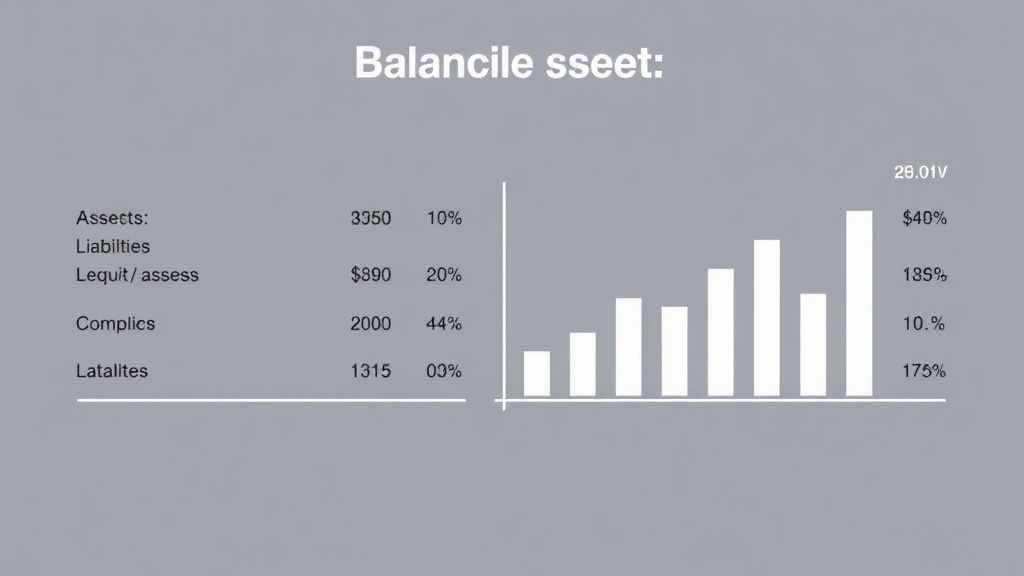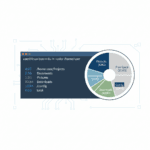Why Learning to Read a Balance Sheet Changed My Investing Game
I used to pick stocks based on headlines and stock tips from Reddit. You know how that ended? I lost $15,000 in six months buying companies I didn’t understand. The turning point came when I finally sat down and learned how to read a balance sheet.
A balance sheet isn’t complicated once you understand what you’re looking at. It’s simply a snapshot of what a company owns, what it owes, and what’s left over for shareholders. Think of it as a financial health checkup that shows whether a company is strong enough to weather storms or teetering on the edge of disaster.
Most investors skip this step and jump straight into buying stocks. That’s like buying a house without getting an inspection. Sure, the kitchen looks nice, but what about the foundation? Understanding the difference between trading and investing means doing your homework on the companies you own.
The Three Components Every Balance Sheet Has
Every balance sheet follows the same fundamental equation. Once you understand this, everything else clicks into place. The equation is simple: Assets = Liabilities + Shareholders’ Equity.
Let me break down what each piece actually means in plain English.

Assets: What the Company Owns
Assets are everything a company owns that has value. These get divided into current assets and long-term assets based on how quickly they can be turned into cash.
Current assets are things the company expects to convert to cash within a year. This includes actual cash, accounts receivable (money customers owe), inventory sitting in warehouses, and short-term investments. If you run a coffee shop, your current assets would be the cash in your register, the beans in your storage room, and the money customers owe you for wholesale orders.
Long-term assets stick around longer than a year. Property, equipment, buildings, long-term investments, and intangible assets like patents or trademarks fall into this category. For our coffee shop example, this would be your espresso machines, the building itself, and your registered trademark.
Liabilities: What the Company Owes
Liabilities are debts and obligations the company needs to pay back. Like assets, these split into current and long-term categories.
Current liabilities are debts due within the next year. Accounts payable (bills the company owes suppliers), short-term loans, wages owed to employees, and upcoming tax payments all fit here. Back to our coffee shop – this is the money you owe your bean supplier, employee paychecks due this week, and your quarterly tax bill.
Long-term liabilities are obligations due beyond one year. Mortgages, bonds the company issued, long-term bank loans, and pension obligations fall into this bucket. For the coffee shop, this would be your building mortgage and any equipment financing that extends beyond twelve months.
Shareholders’ Equity: What’s Left for Owners
Shareholders’ equity is the residual value after subtracting liabilities from assets. This represents what theoretically belongs to the company’s owners if they sold everything and paid all debts.
Equity includes money raised from investors (common stock and additional paid-in capital) plus retained earnings (profits the company kept instead of paying out as dividends). A company with $500,000 in assets and $200,000 in liabilities has $300,000 in shareholders’ equity.
Reading a Real Balance Sheet Example
Let me show you how this works with a simple example. Imagine you’re looking at a fictional retail company called TechGear Inc.
Their balance sheet shows total assets of $850,000. Breaking that down, they have $350,000 in current assets (cash, inventory, and accounts receivable) and $500,000 in long-term assets (stores, equipment, and a warehouse).
On the liabilities side, they owe $320,000 total. This includes $120,000 in current liabilities (supplier bills, short-term loans, and payroll) plus $200,000 in long-term debt (a business loan and equipment financing).
Using our fundamental equation, shareholders’ equity equals $530,000 ($850,000 assets minus $320,000 liabilities). This tells you the company is worth more than it owes, which is a good starting point.
The Key Ratios That Actually Matter
Raw numbers on a balance sheet don’t tell the whole story. You need to calculate a few simple ratios to understand what’s really happening. These ratios help you compare companies of different sizes and spot potential problems.
Current Ratio: Can They Pay Their Bills?
The current ratio measures whether a company can cover its short-term obligations. Divide current assets by current liabilities. A ratio above 1.0 means the company has more short-term assets than short-term debts.
Using our TechGear example, their current ratio is 2.92 ($350,000 divided by $120,000). This means they could pay off their short-term debts almost three times over. Generally, a current ratio between 1.5 and 3.0 indicates healthy liquidity.
A current ratio below 1.0 is a red flag. The company might struggle to pay bills when they come due. I avoid companies with consistently low current ratios unless there’s a very good reason.
Quick Ratio: The Stricter Test
The quick ratio is like the current ratio’s more skeptical cousin. It removes inventory from current assets because inventory isn’t always easy to convert to cash quickly.
Calculate it by adding cash, marketable securities, and accounts receivable, then dividing by current liabilities. If TechGear has $150,000 in cash and receivables (excluding their $200,000 inventory), their quick ratio is 1.25 ($150,000 divided by $120,000).
A quick ratio above 1.0 is solid. The company can pay short-term debts without selling inventory at a discount. This ratio matters more for companies in industries where inventory can become obsolete quickly, like technology or fashion.
Debt-to-Equity Ratio: How Leveraged Are They?
The debt-to-equity ratio shows how much a company relies on debt versus equity to finance operations. Divide total liabilities by shareholders’ equity.
TechGear’s debt-to-equity ratio is 0.60 ($320,000 liabilities divided by $530,000 equity). This means they use 60 cents of debt for every dollar of equity. Lower ratios indicate less financial risk.
What’s a good debt-to-equity ratio? It depends on the industry. Capital-intensive industries like utilities or telecommunications typically run higher ratios (1.0 to 2.0) because they need lots of debt to build infrastructure. Technology companies often have lower ratios (0.3 to 0.8) since they don’t need as much physical infrastructure.
I get nervous when I see debt-to-equity ratios above 2.0 unless the company operates in an industry where that’s normal. High debt means high risk, especially when interest rates rise or business slows down. Risk management isn’t just for traders – understanding a company’s debt load helps you avoid permanent capital losses.
Red Flags I Always Watch For
After reading hundreds of balance sheets, certain warning signs jump out immediately. These red flags have saved me from terrible investments more times than I can count.
Accounts Receivable Growing Faster Than Revenue
When accounts receivable (money customers owe) grows faster than revenue, something’s off. Either the company is extending credit to risky customers, or they’re booking revenue they might never collect.
Compare accounts receivable growth to revenue growth over several quarters. If receivables consistently grow 20% while revenue grows 10%, that’s a problem. The company might be struggling to actually collect cash from sales.
Declining Cash With Increasing Debt
A company burning through cash while taking on more debt is often in trouble. Check if cash and cash equivalents are dropping quarter after quarter while long-term debt increases.
This pattern indicates the company can’t fund operations from business activity and is borrowing to stay afloat. I learned this lesson the hard way with a retail stock that looked cheap but was actually circling the drain.
Mysterious “Other” Line Items
Large unexplained amounts listed as “other assets” or “other liabilities” deserve scrutiny. Companies sometimes hide problems in these catch-all categories.
If “other assets” suddenly balloon or represent more than 10% of total assets, dig into the footnotes. The company should explain what these items are. Vague explanations or refusal to provide details is a massive red flag.
Goodwill and Intangibles Dominating the Balance Sheet
Goodwill appears when a company acquires another company for more than the fair value of its assets. Large goodwill balances aren’t necessarily bad, but they require attention.
If goodwill and intangible assets make up more than 30-40% of total assets, the balance sheet might be less solid than it appears. These aren’t physical assets you can sell if times get tough. When companies write down goodwill, it often signals they overpaid for acquisitions.
Retained Earnings That Keep Dropping
Retained earnings represent cumulative profits the company has kept over its lifetime. If this number consistently decreases, the company is losing money year after year.
Negative retained earnings mean the company has lost more money than it ever made. Startups often show this, which is fine if they’re investing in growth. Established companies with declining retained earnings are usually in serious trouble.
Common Mistakes Beginners Make Reading Balance Sheets
I made every single one of these mistakes when I started analyzing companies. Learn from my expensive education.
The biggest mistake is looking at the balance sheet in isolation. You need to compare it to previous quarters and years to spot trends. A single snapshot doesn’t tell you if things are improving or deteriorating.
Another common error is ignoring the industry context. A debt-to-equity ratio of 1.5 might be conservative for a utility company but reckless for a software startup. Always compare companies to their industry peers, not to companies in completely different sectors.
Many beginners also confuse book value with market value. The balance sheet shows book value – what the company paid for assets minus depreciation. Market value is what those assets would actually sell for today. A factory built in 1980 might be worth far more or far less than its book value suggests.
Don’t forget to read the footnotes. I know they’re boring, but that’s where companies disclose important details about their accounting methods, pending lawsuits, and contingent liabilities. The interesting stuff hides in the footnotes.
How I Use Balance Sheets in My Investment Process
Reading balance sheets isn’t about finding perfect companies. It’s about avoiding disasters and understanding what you own.
When I’m evaluating a potential investment, I start with the balance sheet. I calculate the current ratio, quick ratio, and debt-to-equity ratio. If any of these throw up red flags, I move on to the next opportunity. Why waste time analyzing a company that’s financially shaky?
For companies that pass the initial screening, I compare their balance sheet metrics to industry averages and direct competitors. Is their liquidity better or worse? Do they carry more or less debt? These comparisons reveal competitive strengths and weaknesses.
I also track how these metrics change over time. A company with steadily improving ratios is heading in the right direction. Deteriorating ratios signal potential problems ahead, even if the stock price hasn’t caught on yet.
The balance sheet matters most for dividend investors like me. A company with high debt and poor liquidity might cut or eliminate dividends when business slows down. I want dividend stocks with fortress balance sheets that can maintain payouts through recessions.
Bringing It All Together
Learning to read balance sheets isn’t glamorous. It won’t help you find the next meme stock or day trading opportunity. But it will help you avoid costly mistakes and build lasting wealth through intelligent stock selection.
Start simple. Pull up the balance sheet for a company you already own or follow. Identify the three main sections: assets, liabilities, and equity. Calculate the current ratio and debt-to-equity ratio. Compare these numbers to the previous year.
Do this exercise with five or ten companies. You’ll start noticing patterns and developing an intuition for what healthy balance sheets look like in different industries.
The truth is, most investors never bother learning this skill. They’d rather chase hot tips and follow trending stocks. That’s their loss and your advantage. Understanding balance sheets gives you an edge that compounds over decades of investing.
I’m not saying you need to become an accountant. But spending a few hours learning these fundamentals will save you from expensive mistakes and help you identify truly solid companies worth owning for the long haul. That’s a much better path than the common mistakes that destroy investor accounts.
The balance sheet is your window into a company’s financial foundation. Once you know how to read it, you’ll never look at stocks the same way again.







